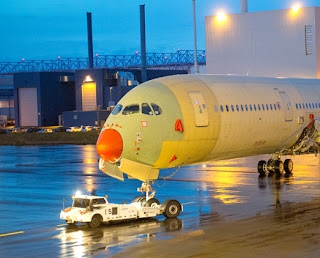The main
landing gear for the -1000 variant of the A350 XWB will be provided by Goodrich
when Messier-Dowty is supplying the main landing gear for the smaller A350-900
and -800.
"The
A350-1000 operates at higher design weights than the A350-900/-800 and features
an all-new, 6-wheel main landing gear compared to the 4-wheel design of the
other A350 models. Airbus launched a call for tender to secure best overall
value for the A350-1000. After thorough evaluation of the competitive bids -
covering a wide range of criteria - Goodrich was selected" said Airbus.
The contract
with Goodrich covers the design, test, manufacture and in-service support of
the A350-1000's main landing gear.
Goodrich says
it expects to generate more than $2 billion in original equipment and
aftermarket revenue for the firm over the life of the program. It says the work
will represent "a global effort" involving Goodrich locations in
Canada, the United States, Poland, India and France, as well as collaboration
with Goodrich's global supply chain.
"This
selection represents a continuation of Goodrich's growing relationship with
Airbus as a key landing gear supplier," said Jack Carmola, president of
Goodrich's actuation and landing systems segment. "This program will allow
us to leverage our experience as the landing gear supplier on the A380 program
and continue with this success onto the A350-1000."
The question
is why a new supplier for -1000 model
instead of French Messier-Dowty as -900 variant?
Goodrich is
not a new supplier for Airbus and for A350 XWB Program:
-Goodrich is
providing all three members of the A350 XWB family's nacelle and thrust
reverser system, wheels and carbon brakes, air data system and ice detection
system, external video system and cabin attendant seats.
-Goodrich is
providing the MLG for A380.
-Goodrich has
a huge experience with Boeing´s MLGs and in 2012 has received a Boeing
Performance Excellence Award for its landing gear business. The award is issued
annually in recognition of superior supplier performance. Goodrich's landing
gear business maintained a silver composite performance rating for the 12-month
period from October 1, 2010 to September 30, 2011.
Finally and
more curious: for A330/A340 the MLG is provided by Messier-Bugatti-Dowty but
wheels & carbon brackets are produced neither by Goodrich nor by Messier; they are
manufactured by Goodrich-Messier, Inc. a
joint venture company which jointly design wheels and brackets and they do
it very well: Airbus recently recognized
Goodrich-Messier Inc. with the Gold award for Best Improver for excellent
on-time delivery and quality performance during 2011 inside the SQIP project
(Supply Chain & Quality Improvement Program). “The Gold award resulted from
a dedicated focus by cross functional teams from both companies on product harmonization and control which
delivered zero rejects in 2011 with on-time delivery performance of 97
percent.”
For A350 XWB, wheels and brakets will be selected by Airlines between Goodrich and Messier, considering both will be certificated before EIS.














































